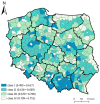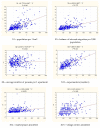Social Factors as Major Determinants of Rural Development Variation for Predicting Epidemic Vulnerability: A Lesson for the Future
- PMID: 36360858
- PMCID: PMC9656134
- DOI: 10.3390/ijerph192113977
Social Factors as Major Determinants of Rural Development Variation for Predicting Epidemic Vulnerability: A Lesson for the Future
Abstract
There have been changes in social attitudes in recent years. These changes have been a consequence of a new societal view of the common good, which manifests itself in social responsibility for a clean and healthy environment. The outbreak and spread of the COVID-19 epidemic has highlighted the socio-spatial variation across regions and countries. The epidemic necessitated restrictive measures by state authorities. In the initial period in many countries, the actions of the authorities were identical throughout the country. This was mainly due to a lack of information about the differentiation of areas in relation to the epidemic risk. The aim of the research was to present a model for classifying rural areas taking into account vulnerability to epidemic threats. The model takes into account demographic, social, economic and spatial-environmental development factors. A total of 33 indicators based on public statistics that can be used to determine the area's vulnerability to epidemic threats were identified. The study showed that for Poland, 11 indicators are statistically significant to the developed classification model. The study found that social factors were vital in determining an area's vulnerability to epidemic threats. We include factors such as average number of persons per one apartment, village centers (number), events (number), number of people per facility (cultural center, community center, club, community hall), residents of nursing homes per 1000 inhabitants, and the number of children in pre-school education establishments per 1000 children aged 3-5 years. The research area was rural areas in Poland. The results of the classification and the methods used should be made available as a resource for crisis management. This will enable a better response to threats from other epidemics in the future, and will influence the remodeling of the environment and social behavior to reduce risks at this risk, which has a significant impact on sustainable development in rural areas.
Keywords: COVID-19; environmental management; epidemic; geographical information system; socio-economic geography; spatial planning; sustainable development; wellbeing.
Conflict of interest statement
The authors declare no conflict of interest.
Figures












References
-
- World Health Organization . Coronavirus Disease (COVID-2019) Situation Reports. World Health Organization; Geneva, Switzerland: 2019.
-
- Tyson A. Republicans Remain Far Less Likely than Democrats to View COVID-19 as a Major Threat to Public Health. Pew Research Center; Washington, DC, USA: 2020.
-
- Rothgerber H., Wilson T., Whaley D., Rosenfeld D.L., Humphrey M., Moore A., Bihl A. Politicizing the COVID-19 pandemic: Ideological differences in adherence to social distancing. PsyArXiv. 2020 doi: 10.31234/osf.io/k23cv. - DOI
-
- Sirkeci I., Yucesahin M.M. Coronavirus and Migration: Analysis of Human Mobility and the Spread of COVID-19. Migr. Lett. 2020;17:379–398. doi: 10.33182/ml.v17i2.935. - DOI
Publication types
MeSH terms
LinkOut - more resources
Full Text Sources
Medical

